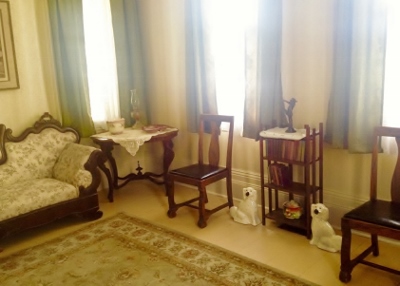Leaskdale Manse National Historic Site of Canada
Leaskdale, Ontario

Interior view
© Yuka Kajihara-Nolan (with autorization | avec l'autorisation)
Address :
11909 Concession Road 7, Leaskdale, Ontario
Recognition Statute:
Historic Sites and Monuments Act (R.S.C., 1985, c. H-4)
Designation Date:
1997-09-22
Dates:
-
1886 to 1886
(Construction)
-
1911 to 1926
(Significant)
Event, Person, Organization:
-
Lucy Maud Montgomery
(Person)
-
William Gordon
(Builder)
Other Name(s):
-
Leaskdale Manse
(Designation Name)
-
Leaskdale Manse Museum
(Other Name)
Research Report Number:
1997-054
Plaque(s)
Existing plaque: front yard 11909 Concession 7, Leaskdale, Ontario
From 1911 to 1926, this Presbyterian manse was home to Lucy Maud Montgomery, the world-famous author whose writing career was launched in Prince Edward Island. Here at Leaskdale she began her role as a wife and mother, and penned 11 books, including sequels to Anne of Green Gables. She also continued to chronicle her own life in candid and colourful journals which were posthumously published. The Leaskdale diary entries portray the manse as a stage for the drama of a demanding and productive part of her life, and provide important insights into her fiction and issues of the period.
Description of Historic Place
Leaskdale Manse National Historic Site of Canada is the former Presbyterian manse where Lucy Maud Montgomery lived with her husband and family from 1911-1926. It is a modest brick late 19th-century house set on a residential lot just north of St. Paul's Presbyterian Church on Durham Regional Rd. #1 in the hamlet of Leaskdale, Ontario, north of Toronto. The designation refers to the house on its legal property.
Heritage Value
Leaskdale Manse was designated a national historic site in 1994 because it was the home of Lucy Maud Montgomery in a productive period of her literary career when she wrote 11 of the 22 works published during her lifetime; her posthumously published journals for 1911-1926, written in the manse, are important literary works that provide for a greater understanding of the author and her early 20th-century work, and permit new interpretations of her fictional writings; and the manse and its immediate environment figure prominently in the journals, being the stage on which the drama of an important part of her life was played and documented.
The heritage value of Leaskdale Manse National Historic Site of Canada lies in its association with the life and later published works of Lucy Maud Montgomery. The value is illustrated in the form, materials, site and setting surviving from the 1911-1926 period when Montgomery was in residence. The house was constructed in 1886 as the manse for St. Paul's Presbyterian Church where Lucy Maud Montgomery's husband, the Reverend Ewan Macdonald, served as pastor from 1911-1926. It was here that Montgomery lived during the first 15 years of her marriage, bore and began to raise her family. It was purchased by the Township of Uxbridge for restoration as an historic site in 1993.
Source: Historic Sites and Monuments Board of Canada, Minute, 1994; Commemorative Integrity Statement, 1999.
Character-Defining Elements
Key elements that contribute to the heritage value of this site include: location of the house adjacent to the Presbyterian church and on a street that remains sympathetic to its early twentieth-century state; its typicality as a late nineteenth-century middle class house, including its two-storey massing, T-shaped footprint and cross gabled roof with single storey rear shed; its yellow brick exterior facing material; its vernacular decorative elements, including a wooden verandah with restrained gingerbread bracketing, wooden side and top-lit entry door, simple wooden window frames; surviving interior layout, fittings and furnishings from the 1911-1926 period;
- landscape features from the Montgomery/Macdonald time period such as remnants of the carriageway, gardens; archaeological evidence from the 1911-1926 period including remnants of the carriage house, well, fence, and the pollen record; viewscapes from the house to rural surroundings, from the second floor windows west to Leask farm and beyond, north to the Leaskdale Creek and south to the church.